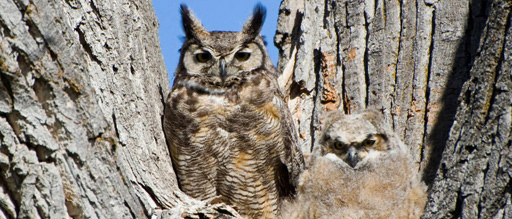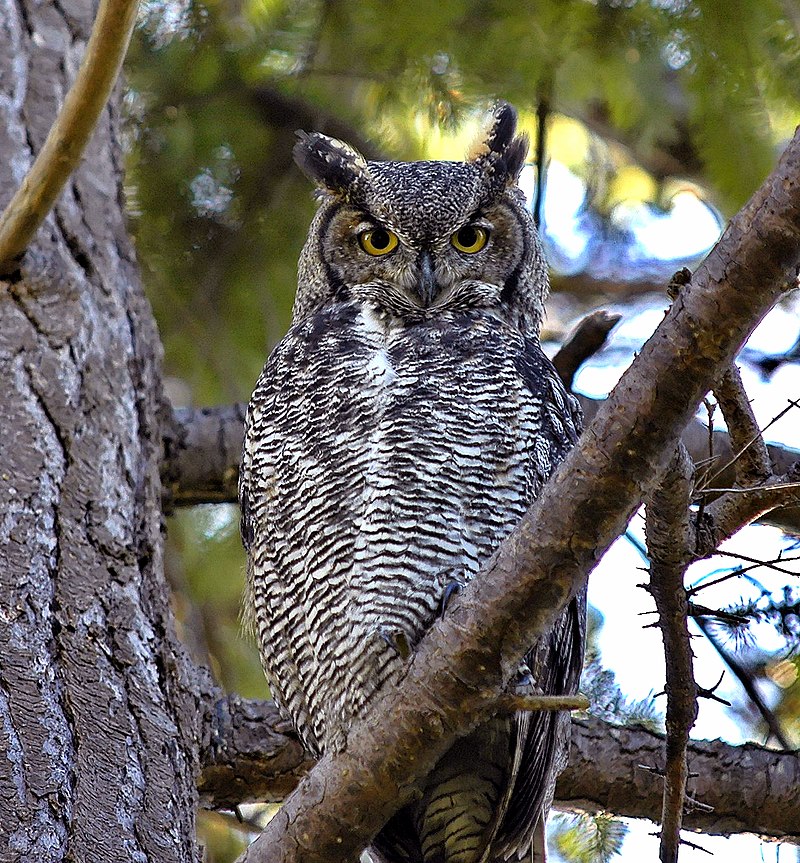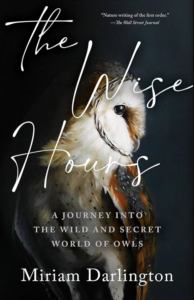By Sharon L. Moore
Bubo virginianus
Order: Strigiformes
Family: Strigidae

Listen carefully these winter evenings and early mornings and you may hear a mated Great Horned Owl pair high up in conifer trees calling back and forth with a haunting, foghorn-like whoo whodo whoo who. Listen more carefully and you’ll hear the female’s calls at a softer, higher pitch than the male’s. As early nesters in January and February, these owls will have established their presence at the nest they’ve chosen and are now defending their territory, warning predators to stay away. If the parents succeed in producing a brood this season, in five or six weeks you’ll hear the fledglings shrieking for food as the parents settle in to their months-long, arduous hunting routines to raise those young owlets to adulthood. With luck, in the fall you’ll hear the entire family hooting again as the now mature younger generation prepares to leave home to establish their own territories.
The Great Horned Owl is an iconic bird, the quintessential owl in legends and children’s stories, symbolizing wisdom, patience and strength. It can be found in most of North America. Though in Western Washington it generally prefers the edges of second-growth coniferous forests, in the broader continental U.S. it may live in a wide variety of terrains, from smaller forests to wetlands, deserts, grasslands, even city parks. The male weighs from 3 to 3.5 pounds and the female outweighs him by up to one-third. With a body 22 inches long and a wingspan of 45 inches, this large owl species is a formidable, powerful, fearless hunter with a well-camouflaged body. The head is large, the eyes yellow, the face light brown with a white throat. The body is mottled grayish-brown with a finely barred lower breast and belly. The large ear tufts of 3 to 4 feathers, which are not the actual ears, are thought to be useful for camouflage, to help obscure the outline of the bird’s head from potential prey.
These birds are skilled, aggressive, tenacious predators that will predate on other bird species, particularly American Crow young in their nests. Though owls have historically been thought to hunt strictly at night, there’s now confirmation that Great Horned Owls actually hunt most often in the hours before sunrise and sunset. In the winter when food supplies are low, they may begin hunting in the evening and continue all night until early morning. Their highly sensitive hearing allows them to locate prey and their excellent vision helps them capture it. Assisting with their hunting accuracy is also their wide field of vision. As with other owl species, they can turn their heads 270 degrees in either direction – three-quarters of a full circle. How is this anatomically possible? The answer is that all owls carry twice as many vertebrae in their necks and twice the blood supply to their brains that we humans do. Hence, they have the energy and capability of repeated, extreme head movements over long periods of time.

Surveying the ground and greenery from high perches, the Great Horned Owls swoop down to grab prey in their talons. Their diet is so varied that it seems no relatively small species is safe from this highly efficient hunter. Scorpions, mice, snakes, lizards and frogs are highly prized, as are opossums, squirrels and rabbits. In our more northern latitude they may also take larger prey such as geese, ducks and smaller owls. Even the occasional skunk or porcupine may tempt them. During freezing winters, they store large prey, returning in warmer weather to defrost and eat the carrion. They may also walk furtively along the ground, stalking prey in the forest understory and even around shrubbery that borders buildings.
Courting begins in winter for these birds. Once the male entertains the female with display flights and feeds her who knows what delicacies, the pair bonds and may roost together near their chosen nest for several months before laying their eggs. They will remain monogamous, mating for life if possible. Generally Great Horned Owls commandeer nests already constructed by larger birds such as eagles, hawks or herons. The owls’ primary requirement is that the site needs enough tree density or heavy brush to provide adequate cover for the nest. They may also nest in cliff-side cavities where they have good shelter from predators and inclement weather. The pair takes up residence after doing minimal nest preparation, usually by adding down feathers, leaves and tree bark. After the female lays a clutch of 2 to 5 eggs, she begins the incubation period of 30 to 37 days, generally incubating alone, with the male feeding her during this time. During this critical period her eggs and nestlings are in constant danger of predation by raptors, crows, raccoons and coyotes. Once the nestlings are born, they are completely helpless, requiring both parents to guard and feed them. At five weeks old the juveniles that have survived may leave the nest and roost nearby while both parents continue to feed them for several months. At seven weeks, the juveniles take short flights and at nine to ten weeks they can fly with ease.
During this nesting period, the male and female viciously defend their offspring, confronting intruders with hissing, screaming and bill snapping. If intruders fail to leave, the owls may spread their 45-inch wings and strike with their talons. BHAS member Bill Tweit, a highly experienced, expert birder, can verify the ferocity of these birds’ defense postures. He describes a recent encounter he had with a Great Horned Owl pair when he and a partner inadvertently flushed the pair away from their nest in a road bank. “Watching them look down at us, hissing and bill snapping as they flew over our heads, was a great reminder of their power and also a reminder that we were glad we weren’t their prey.”
The survival prognosis for the Great Horned Owl population is not well established. They seem to adapt easily to habitat disturbances as long as good nest sites remain available. In recent decades, for example, in the Pacific Northwest, due to logging, they have expanded their ranges into open land and second growth forests. But, while Partners in Flight estimates the global breeding population to be 6 million with 45% of that in the United States, the species has actually experienced a steady decline in the U.S. and Canada in the last five decades. Numbers in the U.S. declined by 33% between 1966 and 2015. In Canada the decline was even steeper for that period, resulting in a total loss of 72%. Since these owls had been heavily hunted up to the mid-twentieth century, hunting of the species was finally banned at that time. However, illegal hunting continues to be a problem. Field biologists have also documented that northern populations of Great Horned Owls rise and fall in cycles with their prey population cycles. It’s reasonable to assume, therefore, that with food sources dwindling due to the effects of climate change, this owl population may seriously decline as global temperatures rise. Along with climate change dangers, however, the most serious immediate threat to these and all owl species is the prevalence of poisoning by pesticides and other toxic substances in the flesh of their prey.







